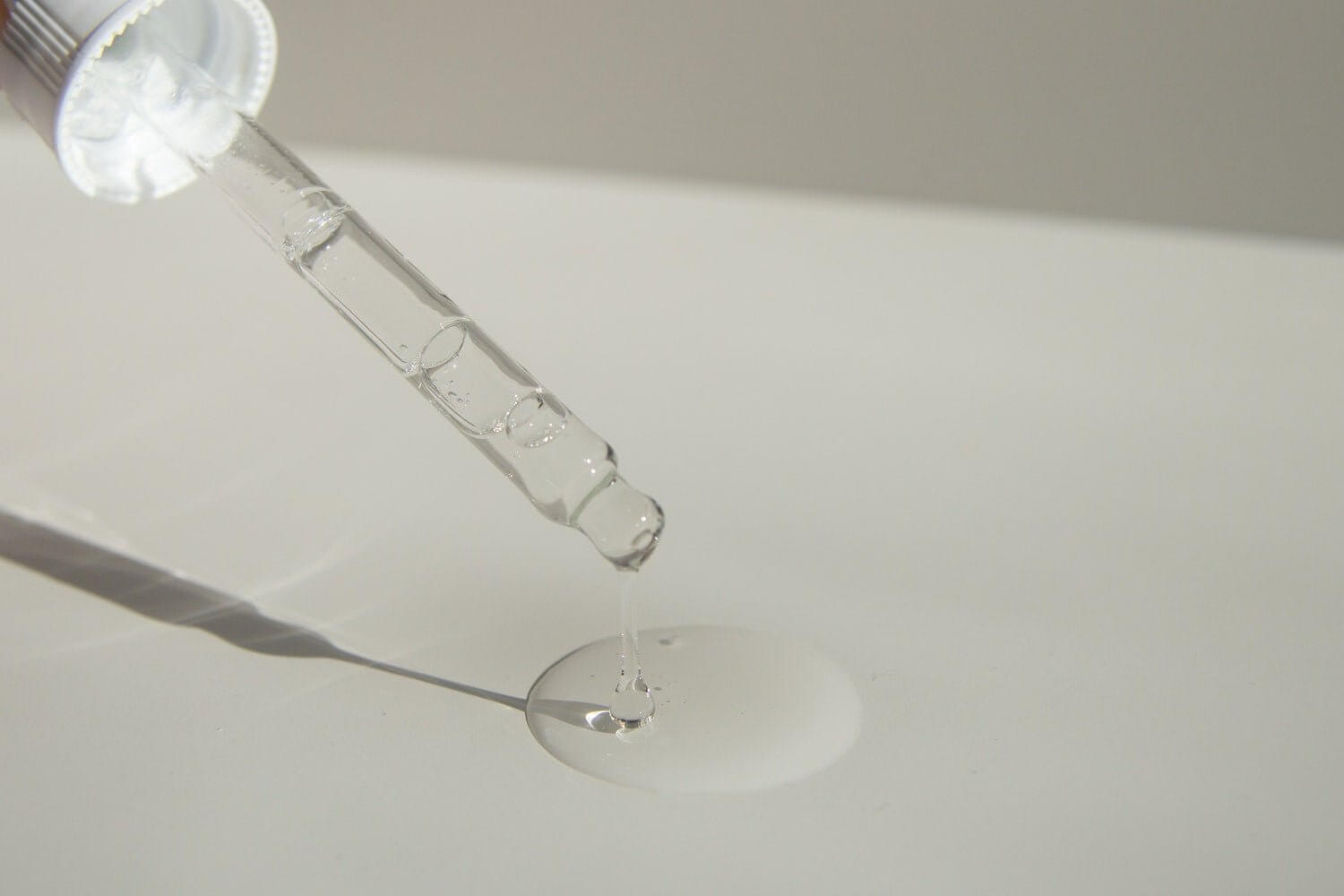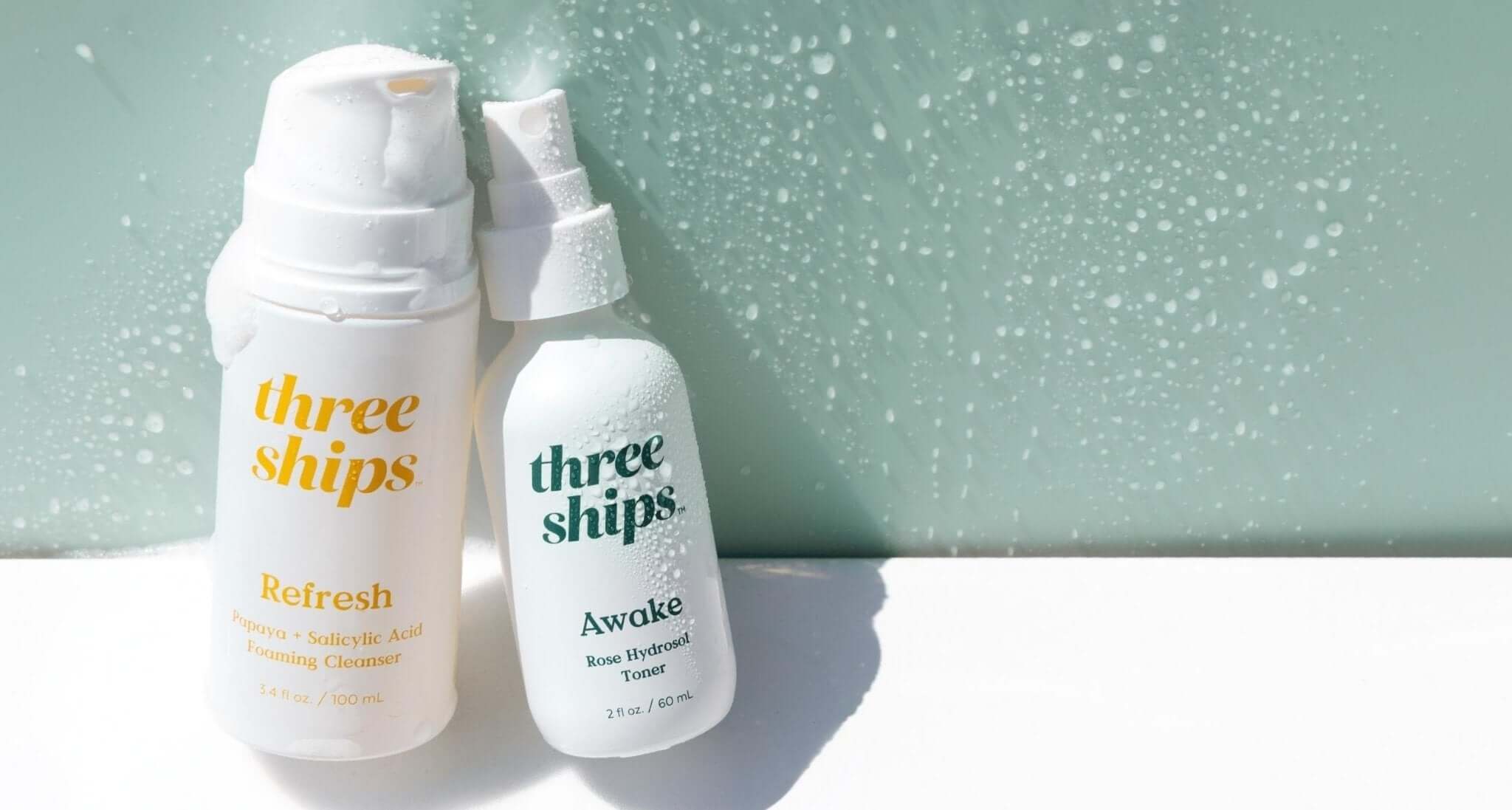Can You Use Vitamin C With Retinol?

Many of us want to achieve a glowing, youthful complexion. Skincare and makeup line our bathroom shelves in hopes of finding the perfect skincare routine that delivers results. But are we causing more harm than good? How do we know which products work together and which ones don’t?
At Three Ships, we’ll share everything you need to know about two of the most popular ingredients on the market, retinol and Vitamin C, and whether or not you can mix these two powerful revitalizing products together.
Vitamin C and Retinol: Can You Mix The Two?
Can you use Vitamin C and retinol at the same time? The answer is yes, and no. It’s just a matter of when you use them. Both products resurface the skin in their own way, and both are potent in reducing the look of fine lines, building collagen, fading dark spots, and pigmentation.
When these two come together, the ultimate skin-enhancing duo forms. When used separately, they target specific concerns, and when misused, they wreak havoc on your complexion. Keep scrolling to learn how to incorporate these two powerful antioxidants into your skincare routine.
What Is Vitamin C?
Vitamin C (L-ascorbic acid) is best known for its presence in certain fruits and vegetables such as oranges, kiwi, grapefruit, and spinach. It is also a magnificent skincare ingredient, and for a good reason. Its potent antioxidant and skin-brightening abilities make it one of the most popular ingredients available today. Vitamin C has a wealth of skin benefits that are worth noting.
What Are The Skin Benefits of Vitamin C?
Vitamin C performs many functions, but it is best known to neutralize free radicals and environmental stressors that can damage your skin.
Environmental stressors trigger free radicals (unstable cells) such as pollution, smoke, stress, and UV rays that break down the skin’s collagen levels which causes the emergence of fine lines, wrinkles, dark spots, and dry patches.
Vitamin C is one of the only antioxidants proven to drive collagen production in the skin, thus making skin appear firmer and brighter.
Vitamin C is also a powerful ingredient that brightens the complexion, reduces dark spots and hyperpigmentation. With continued use, Vitamin C can lessen the appearance of these spots, possibly fading them altogether.
How Does Vitamin C Work?
Vitamin C fights free radicals that affect the skin’s aging process. Free radicals are missing an electron, so they’re unstable and need to be paired with another electron. The unpaired electron causes the unstable molecule to attack a stable molecule and steal an electron.
This theft causes the stable molecule to become unstable. The electron-stealing behavior then causes a chain reaction, causing stable molecules to become unstable.
Free radicals need neutralizing as soon as possible before they cause mass destruction and damage to too many cells. When applied through skincare, antioxidants, specifically Vitamin C, step in and counteract the free radicals by pairing the unbalanced electrons with their missing electron, thus neutralizing the molecules.
What Is Retinol?
Retinols is a derivative of Vitamin A and is an antioxidant that protects the skin from environmental stressors, premature aging, and even acne. Retinol smoothes and regenerates the skin and evens out skin tone. Similar to Vitamin C, retinol has many skin benefits also.
What Are The Skin Benefits of Retinol?
In a study performed in 2000, topical retinol applications show to deter collagen breakdown and increase collagen and elastin production. Collagen creates plump skin, minimizing the appearance of fine lines and wrinkles. Retinol also has a smoothing effect on skin with an uneven texture.
Retinol is famous for its ability to help clear acne, especially cystic acne and smooth acne scarring.
How Does Retinol Work?
Supplementing Vitamin A into your skin care routine encourages cellular turnover. This process is our body’s natural way of shedding old cells and replenishing new ones.
Out with the old dull, dead cells, and in with the new radiant, strong ones. Retinoids (Vitamin A) bind retinoic acid receptors, affecting gene expression. Simply put, retinol lessens the tendency of cells and protein debris to bundle together and clog pores, along with increased collagen and decreasing dark spots.
Our skin faces environmental challenges such as dirt, debris, pollution, and even premature aging are directly linked to air pollutants. Shedding old cells and rebuilding new ones heals and invigorates our skin to a radiant, more youthful appearance.
Incorporating retinol into your skincare routine has a wealth of benefits. Who doesn’t want that?
How Do Vitamin C & Retinol Work Together?
You may be wondering why you would use two products that create the same results together. There’s a lot of confusion around the idea of using Vitamin C with retinol, and most of this confusion deals with pH.
In the past, researchers believed that the pH needed for the absorption of Vitamin C would affect retinol’s integrity, rendering it unuseful. Contrary to these outdated ideas, using Vitamin C and retinol together in your skincare routine provides tremendous benefits when applied the right way.
Retinol stabilizes when combined with Vitamin C, increasing its effectiveness. Vitamin C and Retinol form a protective barrier over the skin that fights skin damage and keeps your skin healthy as you age. This barrier does not mean you can layer the two, one on top of the other, because irritation and sensitivity may occur. However, alternating between the two, along with sunscreen, is ideal.
Why Shouldn’t You Mix Vitamin C & Retinol?
Oil-soluble and water-soluble products don’t mix, just like oil and water don’t mix. This fact is essential to remember when you are applying your skincare.
- L-ascorbic acid (Vitamin C) – Vitamin C is water-soluble. It will only dissolve in water.
- Retinol – Retinol is oil-soluble. It will only dissolve in oil.
Oils create a skin barrier, blocking the absorption of water-based products. Adding Vitamin C (water-soluble) to retinol (oil-soluble) results in the non-absorption of Vitamin C, thus no skin benefits. So, you see how mixing the two is a waste of skincare products, money, and time.
What Are The Benefits of Alternating Vitamin C & Retinol?
Vitamin C and retinol are a match made in skincare heaven. Retinol encourages collagen production (skin’s firmness and suppleness), and when the collagen synthesizes, the Vitamin C acts like glue, holding the cells together. Both Vitamin C and retinol encourage collagen production in the skin.
Continued proper use of Vitamin C and retinol result in the following results:
- Firming and tightening of the skin
- Evens skin tone
- Brightens skin tone
- Helps lightens hyperpigmentation
- Reduces the appearance of fine lines
You need to know a few rules before applying these two potent ingredients.
Tips For Using Vitamin C & Retinol Together
Before you grab your skincare elixirs and begin applying, there are a few tips you must know. There are several ways to alternate vitamin C and retinol effectively, so consider the following information to achieve the best results.
Introduce The Products Slowly
Vitamin C and retinol are powerful ingredients that can cause skin sensitivity, depending on your skin type and tolerance if your skin is not accustomed to the ingredients. Start introducing your skin to these ingredients slowly.
Your skin may be able to tolerate these ingredients every day, or only two to three times per week. It depends. Allow your skin to become accustomed to the ingredients before going in with an intense regimen.
Moving too quickly may cause irritation, dryness, and flaking skin. So, apply once per week, then gradually increase as needed.
Wear SPF
Sunscreen is always recommended for anyone with any skin type, using any skincare products, especially vitamin C and retinol. It protects your skin as you age and wards off skin damage related to exposure to the sun’s UV rays.
- Vitamin C -- Adding SPF every day adds an extra layer of protection against sun damage.
- Retinol – Vitamin A thins the skin’s barrier making it prone to sun sensitivity; thus, retinol amplifies the sun’s effect on the skin.
Be Cautious of Harsh Ingredients
Using active ingredients (Vitamin C and retinol) is highly beneficial to your skin; however, they will leave your skin irritated when they’re overused.
What does “active ingredient” mean? An active ingredient changes the structure of cells, reprogramming them and forcing them to behave in a particular way. These biologically active ingredients are excellent for skin renewal because they penetrate the skin barrier, healing on a cellular level.
Incorporate AHAs & BHAs
BHAs are acids (e.g. salicylic acid) that are natural skin exfoliants, and AHAs (e.g. glycolic acid and lactic acid) are also natural skin exfoliants. Both amp up skincare benefits but irritate the skin if it is already sensitive to Vitamin C or retinol. There are two ways to incorporate these acids correctly when using Vitamin C and retinol.
- Apply in the AM: Apply AHA or BHA in the morning and natural retinol at night. Doing this will decrease your skin’s sensitivity to the sun.
- Stagger it: Use retinol one night and BHA the next, or try alternating Vitamin C with AHAs and BHAs. Staggering these products helps prevent skin irritation and sensitivity.
Keep Your Skin Hydrated With Moisturizer
Dehydrated skin is uncomfortable. Prevent it by keeping your skin well hydrated with a facial moisturizer. Vitamin C and retinol have drying effects on the skin due to the cellular turnover and sloughing of dead skin cells. All skin types experience dryness, and a moisturizer will replenish lost hydration in the skin.
Hyaluronic acid adds intense hydration, as it deeply replenishes moisture. Apply it before your retinol at night to boost the retinol’s effectiveness. Then, top it off with a moisturizing cream to seal it all in.
Be Patient With Your Skin…and Yourself
Everyone's skin reacts differently to Vitamin C and retinol. Some experience dryness and flaking, while others may not notice anything at all. The key is to be patient and consistent. The benefits of using these two powerful skincare ingredients are worth the wait.
How To Combine Vitamin C and Retinol Into Your Daily Routine
Now that you know all of the “rules,” how do you apply Vitamin c and retinol? While used together, these ingredients provide intense results, so it is critical to learn to use the two properly. Here are a few options to consider:
Apply Vitamin C in the Morning & Retinol at Night
Ensure each ingredient works at its full pH potential and separate the two. Use Vitamin C during the day to brighten your skin and combat the day’s free radicals such as pollution in the air, smoke, and UV rays, then apply retinol at night.
This application is the simplest way to use the two ingredients and achieve a brightening and firming effect on your skin.
- Apply Vitamin C on clean skin in the morning, and allow it to soak into the skin for a few minutes. Follow it with a day moisturizer and sunscreen.
- Use a retinol at night since it increases your skin’s sensitivity to the sun’s rays.
Alternate Vitamin C & Retinol Each Night
You don’t always have to apply Vitamin C in the morning since studies indicate that damage from UV exposure occurs hours after the initial exposure. The findings in the study suggest that using a nightly antioxidant (Vitamin C) prevents this damage. So, alternate Vitamin C and retinol each night to reap the benefits without the concern of interactions.
Wait 30 Minutes Between Applications Of Vitamin C & Retinol
If you want to use Vitamin C and retinol simultaneously, wait 30 minutes between applications. Apply Vitamin C first because it is water-soluble and has a lower pH than retinol, allowing it to absorb fully into the skin for 30 minutes.
After 30 minutes, your skin will return to its natural pH level-this is vital so that the Vitamin C doesn’t lower the pH of the retinol and lessen its effect. Next, apply your retinol.
Waiting 30 minutes between these applications allows you to reap the benefits of both products without overloading your skin with acidity.
Bottom Line
At Three Ships Beauty, we emphasize how Vitamin C and retinol are two essential skincare ingredients with potent abilities to penetrate the skin and provide a youthful glow. Be mindful of the ingredients you use on your skin, and read the label before beginning any new skincare product.
Three Ships Beauty Dream Bio-Retinol + Shorea Butter Night Cream is the ideal moisturizer to gently yet effectively incorporate natural retinol into your skincare routine. The cream encourages cellular turnover and evens skin tone with ingredients like Picao Preto (a Brazilian medicinal herb), vegan squalene, and seed butter.
Massage into skin before applying your oil serums intense, skin-smoothing results. It takes time for your skin and the cells to respond to change, but trust us. It is worth the wait.
Sources:
Vitamin C in dermatology | NCBI
Histological evaluation of a topically applied retinol-vitamin C combination | PubMed
Free Radicals and Extrinsic Skin Aging | NCBI
Topical retinoids and acne | NCBI
Vitamin A antagonizes decreased cell growth and elevated collagen-degrading matrix | PubMed
Influences of Environmental Chemicals on Atopic Dermatitis | NCBI
11 ways to reduce premature skin aging | American Academy of Dermatology
Photodecomposition and Phototoxicity of Natural Retinoids | NCBI
Chemiexcitation of Melanin Derivatives Induces DNA Photoproducts Long after UV Exposure | NCBI
- Tags: rec1:dew-drops-mushroom-hyaluronic-acid-vitamin-c-serum rec2:dream-bio-retinol-shorea-butter-night-cream-1 Skin Education
1 comment








Where does Estriol fit in?